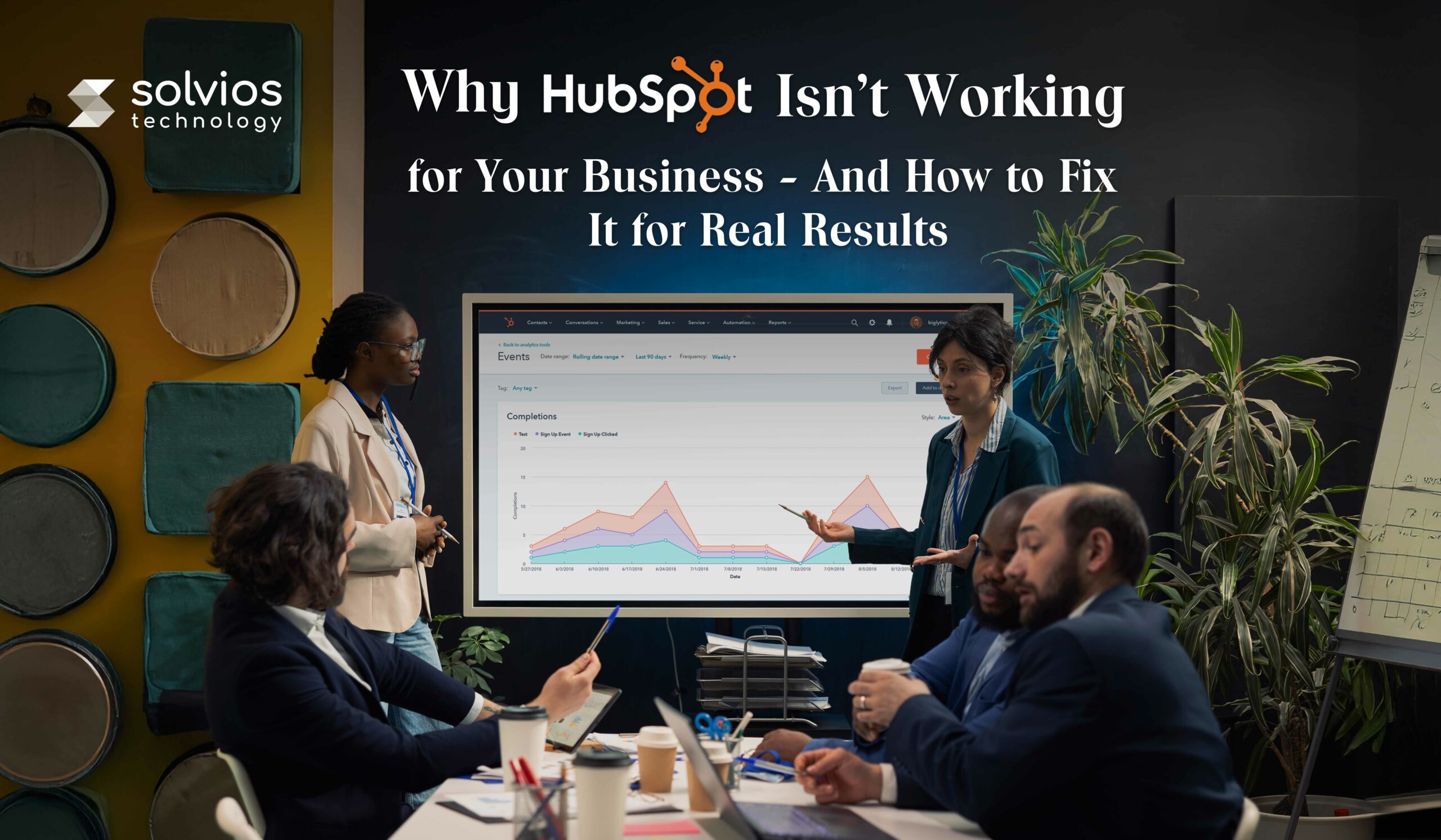
Introduction
Are you a business owner excited about introducing HubSpot into your operations?
While integrating, you may expect streamlined operations, higher sales, and better customer management.
But somewhere along the way, the results stopped matching the expectations.
If you’re part of a growing organization or an enterprise, you might have felt this disconnect. Marketing feels compromised without results. The sales team is juggling multiple workflows, and your tech leaders are struggling to work with a system they don’t understand.
Find yourself in a similar situation?
This blog is here to help you fix HubSpot CRM for real results. Whether it’s a problem with the integration, a strategy misfit, or diagnosing your systems, this blog is for you. Continue reading as we learn more about why your HubSpot isn’t working. Let’s get started.
Warning Signs Your HubSpot Isn’t Working
If you’re facing HubSpot performance issues, it’s because something needs to be fixed. The software isn’t compromised, but the strategy, setup, or usage isn’t well-aligned with your operations.
Still confused? Check out some warning signs to watch out for:
a. CRM data is messy and inconsistent
If your database contains duplicates, missing information, or inconsistent formatting, your team spends time second-guessing lead quality. This further results in poor targeting, inaccurate reports, and broken workflows that rely on clean input.
b. Reports aren’t showing valuable insights
A dashboard displaying multiple metrics is of little value if it doesn’t simplify decision-making. If your reports fail to address key questions about campaign performance, your team will be left behind.
c. Low platform adoption from your team
Does your team use HubSpot regularly? If not, they might feel misaligned or confused with your daily workflows. You may notice reps reverting to manual processes or siloed tools, forgetting the purpose of HubSpot integration.
d. Automated workflows are broken or ineffective
Are your automated workflows underperforming or ineffective? Poorly configured workflows can cost you results. If leads aren’t moving the funnel, it’s time to analyze your automation.
e. Leads drop off after form fills
Capturing leads is the first half of customer acquisition. If you have users submitting forms but not converting, you’re missing out on potential revenue. Such breaks in the process highlight disconnected workflows or poorly aligned lead-nurturing strategies.
f. Campaigns aren’t converting
Having trouble with email open rates or paid ad efforts? Chances are, how you’re using HubSpot is the platform. Repeated underperformance across your workflow highlights an issue with timing, segmentation, or messaging alignment.
g. Sales and marketing teams are misaligned
If your sales team isn’t satisfied with lead quality and the marketing team doesn’t know what happens later, it’s clear that your HubSpot lacks alignment. Without shared visibility, SLAs, or integrated pipelines, you’re losing efficiency and leaving revenue on the table.
Ready to turn those warning signs into growth opportunities?
Contact us NowWhy Your HubSpot CRM Isn’t the Problem — Your Setup Might Be
HubSpot is a complete CRM that manages your entire workflow. However, if your operation continues to face HubSpot performance issues after the implementation, the issue likely lies in the implementation.
So if you’re facing a similar situation with HubSpot, it’s time to find the problem in your workflow. Book a free 30-minute discovery call to diagnose your setup and unlock HubSpot’s true potential for your business.
Common HubSpot Implementation Mistakes – How to Fix Each One
Poor CRM Architecture & Data Management
Why does it happen?
Without proper structure, HubSpot performance issues are pretty evident. It becomes cluttered with duplicate contacts, inconsistent field entries, and integration sync issues.
How to fix it:
Revamp your data storage approach with a comprehensive data audit. Set up deduplication rules, standardize field naming, and build validation workflows. Review your setup for any errors to ensure smooth operations.
Low Team Adoption
Why does it happen?
If teams aren’t trained on using HubSpot, they might avoid using it completely. It could further result in a rushed onboarding and clunky workflows that impact user interaction.
How to fix it:
Build user-specific dashboards. Appoint internal HubSpot champions who provide peer-level support. Run tailored enablement sessions so teams see direct value in the system and adopt it naturally.
Ineffective or Broken Automations
Why does it happen?
Many teams over-automate or set up complex workflows. These tend to break sequences and damage customer experiences without anyone noticing.
How to fix it:
Establish regular automation audits. Align every workflow with a funnel objective. Simplify triggers, remove redundancy, and test new automations in the sandbox before launching live.
Useless Reporting & Dashboards
Why does it happen?
Dashboards often focus on vanity metrics or generic reports. Without input from each team, reports miss the mark and fail to drive action. They look nice, but don’t answer the right questions.
How to fix it:
Identify your key KPIs based on business goals. Then build dashboards specific to each department’s needs. Make them actionable – reports should help teams course-correct, not just observe.
Sales & Marketing Misalignment
Why does it happen?
Sales gets flooded with unqualified leads, while marketing wonders why conversion rates drop. There’s no shared funnel or consistent feedback between the teams.
How to fix it:
Create clear definitions for lead stages, including MQL and SQL criteria. Set service-level agreements. Build structured feedback loops and conduct regular check-ins to bridge the gap.
The Real Cost of A Broken HubSpot Setup
Running an effective HubSpot setup brings more opportunities for any business. However, HubSpot integration issues can result in lost opportunities, wasted budget, demotivated teams, and poor pipeline visibility.
Not to forget, HubSpot implementation problems can cost mid-sized businesses nearly 25% of their revenue in lost opportunities.
How We Help You Fix HubSpot (Without Starting Over)
At Solvios Technology, we understand the importance of having sound HubSpot integration and streamlined operations. Therefore, we’ve designed our 4-step HubSpot consulting services that help you fix the problems in real-time.
Here’s a closer look at the different steps involved in the process:
Step I: Audit & Discovery
We start the diagnosis with a detailed audit of your systems. Our experts analyze your systems to understand if your business goals align with HubSpot challenges. Getting a closer look at the data quality, user adoption, and workflows gives us an idea of what’s working.
Step II: Fix & Reconfigure
Once we understand your requirements, we undertake a full review of your HubSpot setup. Our specialists examine your CRM’s data quality, setup, processes, automation, and connectors to identify the root cause of inefficiency. This deep dive provides a detailed roadmap of what needs to be changed, offering complete visibility into the issues affecting your HubSpot performance.
Step III: Integrate & Align
With a precise diagnosis in hand, we make specific modifications that ensure HubSpot meets your company’s demands—helping you determine when to meet a HubSpot consultant for maximum impact. Each solution is designed to improve how your team utilizes HubSpot daily, from data cleansing to process configuration, automation, and connectors. We guarantee that every change improves the user experience, increases efficiency, and directly contributes to your business objectives.
Step IV: Train & Support
Following the first adjustments, we provide your staff with the skills and knowledge they need to maintain HubSpot going forward effectively. Our training courses address your setup and provide best practices for maintaining performance. Once done, it’s time for ongoing adoption and optimization.
Ready to streamline your operations? Start with a free HubSpot troubleshooting call today!
Need to Fix your HubSpot system for good and see real results?
Contact us NowConclusion: Get Your HubSpot Working for You Again
Remember, it’s rarely the platform holding you back; it’s how it’s been set up and managed. With the proper structure, clean data, and team alignment, HubSpot can become the growth engine it’s meant to be.
Don’t wait for problems to pile up. Begin by conducting a CRM audit, then revisit your automations and re-engage your teams. A few smart changes today can bring clarity, speed, and results back to your entire process.
Frequently Asked Question
HubSpot may not be delivering results due to poor CRM architecture, low team adoption, misconfigured automations, or lack of alignment between sales and marketing. It’s usually not the platform, but the setup or strategy that needs fixing.
Common mistakes include messy data, broken workflows, lack of user training, misaligned reporting dashboards, and weak lead management. These reduce the platform’s overall effectiveness.
Start by auditing your current automations. Align them with funnel stages, remove redundancy, and simplify triggers. Test changes in a sandbox before deploying live to prevent disruption.
Low platform adoption typically happens when users are not trained properly or the interface doesn’t match their workflow needs. Tailored dashboards, role-specific onboarding, and ongoing training help improve adoption.
Look for signs like inconsistent data, low conversion rates, ineffective reports, or siloed team workflows. These indicate that the setup, not the software, is the core issue.
Yes, with the right consulting approach, you can audit and reconfigure your existing HubSpot setup. This includes optimizing data, workflows, automation, and team training—without a full reset.
A typical HubSpot audit reviews data quality, user behavior, workflow performance, reporting effectiveness, integration issues, and team alignment to identify gaps and improvement areas.
Tags
Related Blog
Want to get started with App Development?
These applications are acquiring enormous prevalence by offering hands-on enterprise mobility solutions for organizations around the globe.
Start A Conversation















